UPDATE: Keen to give this project the go-ahead?
Head here for our Quick Feedback Guide!
or, if you have more time and/or are curious
Scroll down for our detailed design thoughts
Feedback is now open on the revamped designs for Grey Lynn, which include not only neighbourhood bikeways, but great stuff for pedestrians, more trees, and quality landscaping. Here’s Auckland Transport’s project page with full info and detailed plans – and the consultation brochure. Feedback is now open until Friday 14 December.
We’ll be back with more nuanced observations, but for now we’ll keep it simple. This is beautiful, smart, proud design. It puts pedestrians first, creates safe and connected bikeways for kids and adults alike, and greens the streets by adding over 200 new trees. It’s a model for neighbourhoods across Auckland. We’re excited, and you should be, too!
So it’s time to say yes to beauty, and yes to streets that help the youngest and oldest get around. It’s time to rise above negativity and embrace positivity. YES to protected bike lanes for safety and comfort, for riders big and small! YES to raised side road crossings for a quality pedestrian environment! And YES to heaps of new trees and higher quality streets!
Ordinarily we’d have a few things we’d ask you to make a noise about to ensure AT will fix them before construction. (And if you prefer to give in-depth feedback, you can hold for a while longer until we identify any niggles we still have.) But this time, we’re confident AT is on the right track – so the main thing is to enthusiastically support this bold, exciting move towards beauty, safety, and connection.
Here’s the feedback button… go for it!
So what’s the plan?
As we previously reported, the designs for these two neighbourhood routes have been under review all year, with input from community representatives and design work by Boffa Miskell. Now it’s time for the public to see them. After the feedback, there’ll be more design, and then – fingers crossed – construction would start in late 2019, for completion within a year. That’s three years behind schedule…
… but, ultimately, should be worth the wait. Now is a critical moment, not just for Grey Lynn, but for Aucklanders at large. If Auckland Transport gets this project right, it will restore trust in the idea that our streets can be made both safe and lovely. And then we can all start to get excited about how our neighbourhoods can be transformed in our lifetimes.
AT is looking to prioritise the works, which makes sense. Everybody wants to see the work done efficiently and effectively, with a minimum of disruption, and with maximum value for money. But let’s be clear: the cost of not delivering this project would far outweigh the cost of just cracking on and building it right. People and design must come first, because this is about realising a fresh and complete vision for healthy, beautiful streets that can then be built anywhere.
What’s in that vision? Here we go…
Route 1 – Surrey Crescent to Garnet Road
This section features two primary schools – Grey Lynn and Westmere; several clusters of local shops, including Old Mill Village, and several busy intersections that are currently very forbidding for walking and biking, including the Richmond Road/ Surrey Crescent junction, the top of the Bullock Track, and where Motions Road meets Old Mill Village.
The design will add:
- Raised tables at side streets and at pedestrian crossings, to calm vehicle speeds.
- New pedestrian crossings.
- 129 new trees!! Plus more greenery and planting in general.
- A mix of bus-stops along the way.
- And of course, continuous bikeways on both sides of the street! On-road, these will be protected from parked cars by a raised separator – and, wherever they pass schools or shops, they’ll be raised to the level of the footpath, but separated from it, Copenhagen-style.
You can see the detailed plans and typical cross-sections over on the project page. A picture’s worth a thousand words, so here’s what the combination might look and feel like in practice. [All renderings by Auckland Transport/ Boffa Miskell.]
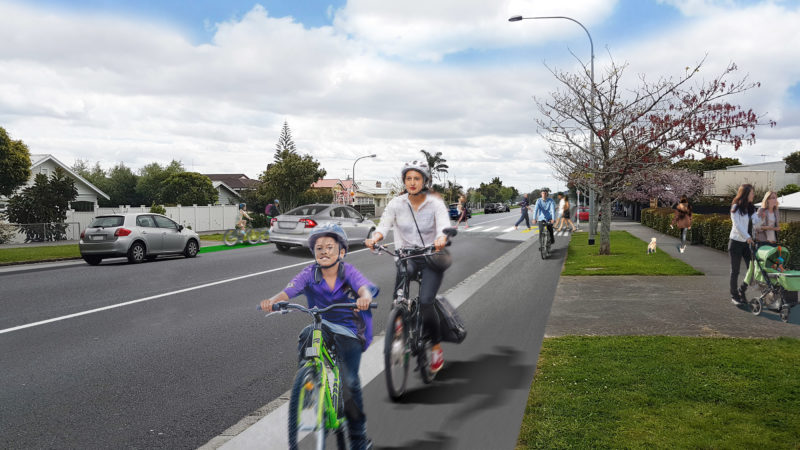
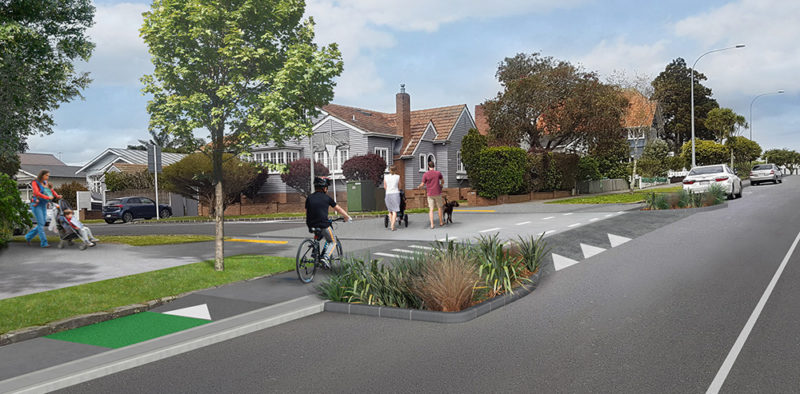

Route 2 – Richmond Road
This section includes the West Lynn Village shops, where the works in general really weren’t up to scratch last time round, and the bikeways weren’t brilliant. Happily, the new design manages to serve all desired outcomes, straightens out the bendy bikeways (yes!) and miraculously also manages to keep as much parking as possible.
Major new features include:
- Fixing the stormwater and ponding issues (this is an essential task, which adds to the overall cost).
- New and relocated pedestrian crossings, with less steep access (this is crucial for accessibility).
- 89 new trees (!!) and more planting for a greener, more vegetated streetscape.
- Measures to slow vehicle speeds, like raised tables at all side streets.
- Relocated bus stops, in line with traffic.
- And, of course, continuous separated and connected bikeways, with people using the on-road sections protected by wide separators and parked cars; and adjacent to (but separate from) the footpath as they travel through the village.
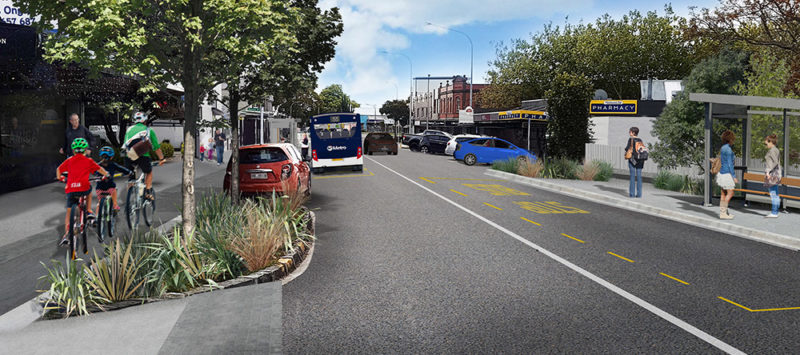
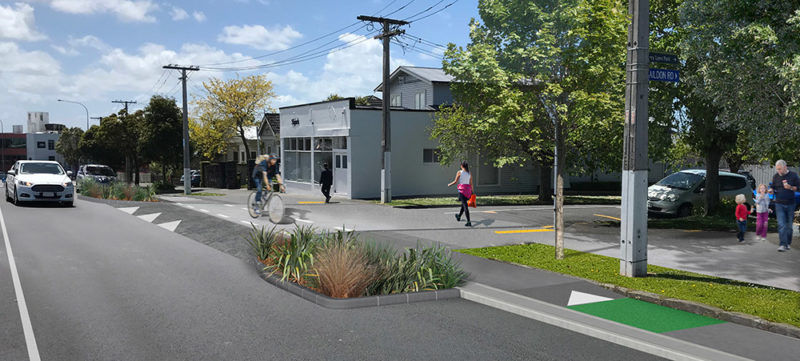
So, that’s the quick overview. As we said earlier, we’ll be looking more closely at the details in the next weeks, especially the intersection designs, such as the Surrey Crescent / Richmond Road T-intersection, and the roundabout at Richmond Road / Peel Street. But the important thing is that these designs don’t need any loud calls to fix core issues.
What we need from the community at large right now is a huge vote of confidence in Auckland Transport’s new approach to neighbourhoods.
Street design can no longer be about ushering cars like VIPs through every street and then squeezing everybody who walks, bikes, or buses into what’s left over. This is a wholesale rethink that finally taps the power of great streets to make things better for everyone – with greenery and beauty, smooth travel and safety – welcoming walkers and bikers alike, and bringing local streets and shopping villages back to life.
It’s been quite a journey, but we’re nearly there. As well as embracing the big picture of what healthy streets might look like, AT has lifted the idea of ‘cycleways’ out of the gutter and into the realm of everyday transport for everyday people. Our streets shape our whole lives. This design shapes them for the better, and sets a new standard for what Aucklanders can and should expect.
We love it. Please support it and spread the word. Thanks!
UPDATE: If you’re interested in making a more in-depth submission, or simply curious about what could be improved, read on:
As we said at the beginning of this blog when we initially wrote it: this design has no fatal flaws. It’s great.
Of course, there are still things that could be and should be improved – which we’ll include in our detailed feedback to Auckland Transport.
Safer speeds – in deed AND word
Much of the changed streetscape will function as a 30kph zone by design, thanks to the (intentionally) much narrower lanes, the generous use of raised tables, and the removal of flush medians. But it would be great to formally lock this in with 30kph speed zone signage.
At the absolute minimum – or shall we say ‘as a first step’, we’d like to see the town centres and school sections along the route designated as formal 30kph zones. Safety for the people visiting our shops and our children going to school is well worth the few seconds travel time for motorists.
The Auckland Transport Board has approved consultation on a significant number of 30kph zones in 2019,to deal with Auckland’s road safety crisis. This was delayed by a few months, amid groups like the AA expressing concerns that some key streets don’t quite speak the 30kph language. In Grey Lynn and Westmere, the situation will be the opposite: the ‘body language’ of the streets will say slow down, so let’s make sure the ‘sign language’ is there too.
Unambiguously (a)cross
The current raised entries at side streets, if you look closely, still are a bit unclear on priority – will pedestrians have right of way even where there are no painted zebra stripes across the side roads? And, while we assume bikes on bikes heading in a direct line will have right of way, how will this work legally, when outdated laws still don’t allow a bike lane priority unless it is on the road level?
There are two ways to deal with this – the workaround, and the law change. The law change to give pedestrians (and bike lanes) right of way across side streets – the same right drivers currently have on the road! – has been mooted for a while, and if it comes in before the Waitemata projects open, great!
If not? Well, as we discussed with Auckland Transport, priority can be provided simply with a green paint line and a few signs that require drivers to give way, and adding the requisite white stripes etc for pedestrians. Ideally, we’d avoid cluttering the place up with more signs, but if we have to do it for an interim period to give bikes and pedestrians priority, then under the current rules we very definitely can.
In the meantime, nothing about the physical design of the proposal poses any problems. Whether the law changes, or the workaround is used, the geometry does not have to change. Moreover, the proposed geometry will make either solution safe – because the raised tables slow down turning drivers, and because the sideways off-set (with parking and landscaping strips) means drivers don’t conflict with bikes until several metres into their sideways turn. This improves sightlines and reaction time and space for all users – whether walking, cycling or driving. (Iit also makes it easier for drivers to pause out of the live traffic lane, which will make them feel less pressured).
That said, for now we should strongly emphasise that providing priority for feet and pedals across the side streets is the only real way forward!

And to your right…
…you currently see limited options for turning into some side streets. You’re rolling along in the nicely protected bike lane, but then you want to turn into the street your sweetheart lives in. How do you do that, when the plans show parking, or an unbroken protection buffer?
Let’s look at what those paragons of bike quality do in Copenhagen – surely they provide a dedicated turn facility for every side street?
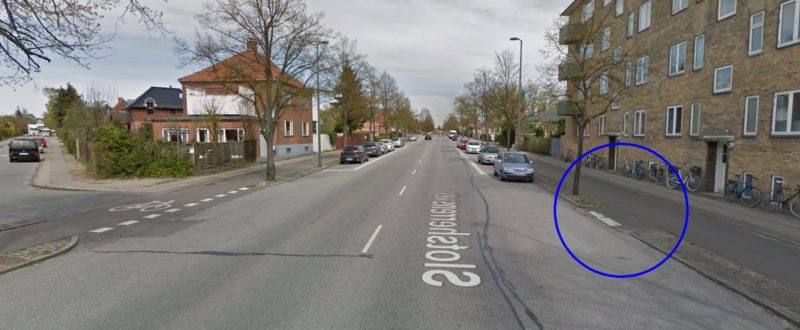
Nope: turns out they simply use driveways themselves – or, where there are no convenient driveways, they simply add a little break.
The same can apply for the Auckland designs. With parking retained in pretty much all sections, as long as there’s a convenient break in parking and buffer, you can turn out of the bike lane (keeping it free for people wanting to go straight while you wait a short moment for a gap in traffic), wait in the parking zone (the 2.1m width is easily enough for a bike), and then cross when the road is free. Or you can do the whole manoeuvre in one gentle turn without stopping, if a quick check shows there’s no traffic to wait for.
As we and others have identified, there are a few locations in the current designs where no right-turn-for-bikes gap has yet been allowed for, with either offset driveways or no driveways. This can be resolved by shuffling around or removing a small number of car parks.
The one other physical thing we may need in current Auckland conditions: a small island at the end of the parking zones before the gap, to deter drivers from parking across the gap (Auckland drivers don’t tend to block each other’s driveways, but we don’t quite have the same culture yet for bikeways…).

Take a narrower view
There are a few places, especially along Route 1, where we feel the turning space given to drivers is still a bit too generous. In the case of Old Mill Village, two side roads have been pushed together when they should stay apart.
These can be tweaked during detailed design, but it’s important to push for this now. AT’s new guidelines allow for narrow side streets, where the rare large truck can track over the other lane, as they do in dozens of European countries already – or in such exotic places as Ponsonby’s historic back streets.
The examples on Route 1 that could use some tightening up include the Bullock Track and Prime Rd; and West View Rd / Old Mill Rd (see at right). On Route 2: Richmond Rd, we didn’t see any significant candidates for further narrowing.
Intersect safely
If you looked at AT’s detailed plans for Surrey Crescent, you may have noted that AT have blanked out the intersection of Surrey Crescent and Richmond Road (though underneath the blanking, there’s a relatively complex potential signalised intersection).
The reason why this one is tricky for AT is that it is the biggest intersection in the two combined projects – it’s where they meet, in fact. It’s currently not signalised, but pedestrians need safer crossing options here, and people on bikes need safe right turns.
The size of the streets and the volumes of traffic make that much more difficult to achieve here than at the small side streets we discussed above. Unlike at Old Mill Village, less confident riders can’t use an immediately convenient zebra crossing to make the turn either.
So what to do?
AT have looked at a few options, including the above-mentioned traffic signals (with signalised bike/pedestrian crossings), and a roundabout (which could perhaps work, if it is single-lane and has proper bike and pedestrian priority crossings). But each has pros and cons.
We don’t yet have a strong opinion on this, but one thing we know: it should be traffic calmed in itself. No matter whether it’s a roundabout or a signal. Because even a signal is not automatically safe – as we know only too well, red lights doesn’t protect against speeding and red-light running. And even good roundabouts can be raced through by small cars when they’re built large enough to let a bus through, too.
So whether roundabout, signal, or something closer to what’s there now – all should be raised onto a platform to slow down vehicle traffic to survivable speeds. Historically, the idea of placing signals on raised tables was frowned upon, or simply not really considered. But Auckland already has one such design, in New Lynn. Why not more? Combined with fewer traffic lanes than the New Lynn example, this could be a really great outcome.

Round and round we go
One other intersection that needs some more love is the Peel Street roundabout on Richmond Road. There’s a couple of things we feel really need to be tweaked (in contrast to our comments above which are small tweaks to great designs).
Thankfully it won’t take much change to what has already been built:
- The sweeping left turn from Richmond Road (up from the Countdown) into Richmond Road (towards the village) could be made tighter. This will also help with…
- …safe crossings over the currently missing pedestrian and bike crossing leg on the village side. Otherwise, it gets really difficult for people on bikes to turn right into Kingsley St. Safe provision for this movement is the key necessary change here.
- And finally, the refuge crossing on the eastern Richmond Road leg? Well, that’s a bit mangy and limited, is it not? AT can do better, as they show through the whole project, and even on the same roundabout!
In the trenches
And for our last improvement suggestion, let’s talk about kerbs. You know, those vertical things? Except, on the bikeway, we’d prefer them not to be!
Throughout much of the design, the bikeway will be sitting on the carriageway level, with concrete separators to your right, and the grass berm and existing kerb to your left. But it’s still not quite wide enough to make overtaking easy.
Widening the bikeways would add significant extra costs, or require compromising on other long-debated elements.
But! What can be pretty easily done is make sure that as much as possible of the bikeway ‘trench’ between kerbs is useable, such that, if you come too close to a kerb, you don’t come a cropper.
The solution? Do what others overseas have done in this situation, and instead of a vertical kerb, use an angled or ‘mountable’ kerb. Not because you’re randomly going to MTB up onto the grass berm. Rather, a slanted kerb gives your pedal a bit more space, and ensures that if you accidentally hit it with your wheel, you ride up instead of glancing off and going into a wobble-spin that might cause a crash.
The good thing? AT have already given their blessing to these new-style kerbs, and is planning to use them in the K Road design, which breaks ground soon. It makes sense to use them here too, to make it easier and safer to ride.
And in summary…!
Even a great design can be even better. Best of all is that this design gets the go-ahead, from as many of us as possible. Please remember to add your voice before Friday 14 December, so we can make this bikeway the real life blueprint for more bikeable neighbourhoods across the city!





